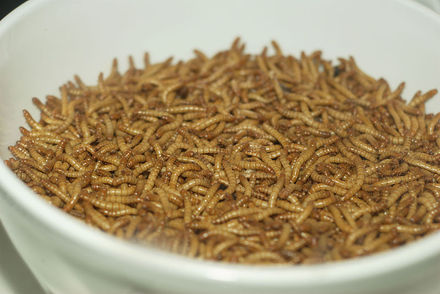An article published by the Kentucky Equine Research staff, the use of protein derived from insect larvae in future horse feed makes for interesting reading. As we all know, all animals need protein as part of their diet.

Meal worms - Protein source for horse feed?
Protein derived from insect larvae has been suggested as an alternative source of protein in horse feed because insects are a sustainable resource that can produce high-quality protein.
© 2012 by Peter Halasz
Dietary protein is particularly important for young growing animals that are building muscle and other body tissues. Lysine and threonine are two essential amino acids contained in high-quality protein that should be an ingredient in feeds for young horses.
While protein is a key ingredient in horse feeds, it is also one of the most expensive components, partly because protein is in high demand and somewhat limited supply. Soybeans are incorporated into feeds for horses and cattle, and fish meal and soybean meal are common sources of protein in feeds for poultry and swine. There is always interest in new and innovative sources of protein for animal feeds.
Protein derived from insect larvae has been suggested as an alternative source of this important feed component. Insects are a sustainable resource that can produce high-quality protein. In a study that compared meal made from housefly larvae and pupae to fish meal and soy meal, insect protein compared favorably as to gross energy and also the essential amino acids lysine and threonine. Housefly larvae and pupae meal had inverted calcium to phosphorus ratios that were somewhat more extreme than in fish meal and soy meal. The study was conducted at Stellenbosch University in South Africa.
“Insect flour” (dried and ground insect larvae and pupae) is produced on a small scale in the Netherlands, where zoos and pet stores are regular customers. Black soldier flies, common houseflies, and yellow mealworms have been judged the most suitable species for large-scale production. The larvae can be grown rapidly on various types of readily available organic waste, so minimal cost would be involved in feeding the larvae.
A major problem in producing insect protein is the small size of the larvae and the large numbers that would be necessary to produce commercially useful amounts of protein. Currently, the Food and Environment Research Agency in England is investigating the practicality of developing sources of insect protein for use in animal feeds.
In some countries, grubs and other insects are eaten as a snack by people. The time may be coming when animals, including horses, regularly share this “Bug Mac” feed ingredient.
Content for news article by Kentucky Equine Research Staff
